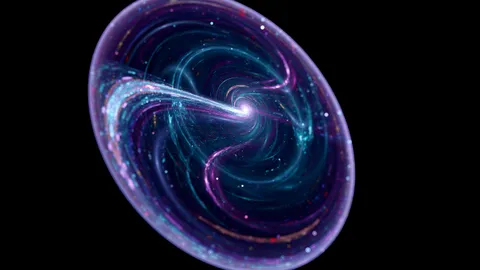Gravitational waves from colliding black holes could reveal if they are actually fuzzballs.
Key Takeaways
- A bold new theory suggests black holes might actually be “fuzzballs” — cosmic string balls.
- Fuzzballs, derived from string theory, could replace black holes in explaining gravitational anomalies.
- Unlike black holes, fuzzballs have no singularity or event horizon but are densely packed strings.
- Upcoming gravitational wave detectors like advanced LIGO may reveal fuzzballs through unique wave patterns.
- Discovering fuzzballs could unlock profound secrets about the universe’s fundamental nature.
_____________
Are Black Holes Just Fuzzballs?
Black holes, long considered the universe’s most mysterious objects, might not exist as we imagine them. According to a revolutionary theory rooted in string theory, these gravitational anomalies could instead be fuzzballs—dense, string-like entities that sidestep the concept of a singularity and event horizon.
String theory proposes that all particles and forces are made of tiny, vibrating strings, which form the fundamental building blocks of the universe. This framework offers a potential solution to the long-standing paradoxes surrounding black holes, such as their singularities—infinitely tiny points where the laws of physics break down—and the Hawking radiation paradox, which questions the fate of information falling into black holes.
Fuzzballs replace the singularity with an ultra-compressed sphere of strings, likened to a neutron star’s structure but composed of subatomic strings instead of particles. While the theory remains incomplete, its implications are significant, offering an alternative explanation for phenomena previously attributed to black holes.

How We Might Detect Fuzzballs
To differentiate between black holes and fuzzballs, researchers are turning to gravitational waves—ripples in spacetime caused by cosmic collisions. When black holes merge, they emit specific gravitational wave signatures that have so far aligned perfectly with Einstein’s general relativity. However, fuzzballs might produce subtle deviations from these patterns, providing a way to confirm their existence.
Future advancements in gravitational wave detection technology, such as the upgraded Laser Interferometer Gravitational-Wave Observatory (LIGO) and the proposed Laser Interferometer Space Antenna (LISA), could provide the necessary sensitivity to identify these variations. These instruments will allow scientists to probe the inner workings of these mysterious objects and test competing models.
If fuzzballs are detected, it would mark a groundbreaking moment in physics, answering questions about black holes and offering new insights into the universe’s fundamental laws. While the theory is still developing, its potential to transform our understanding of reality makes it a fascinating area of study.




